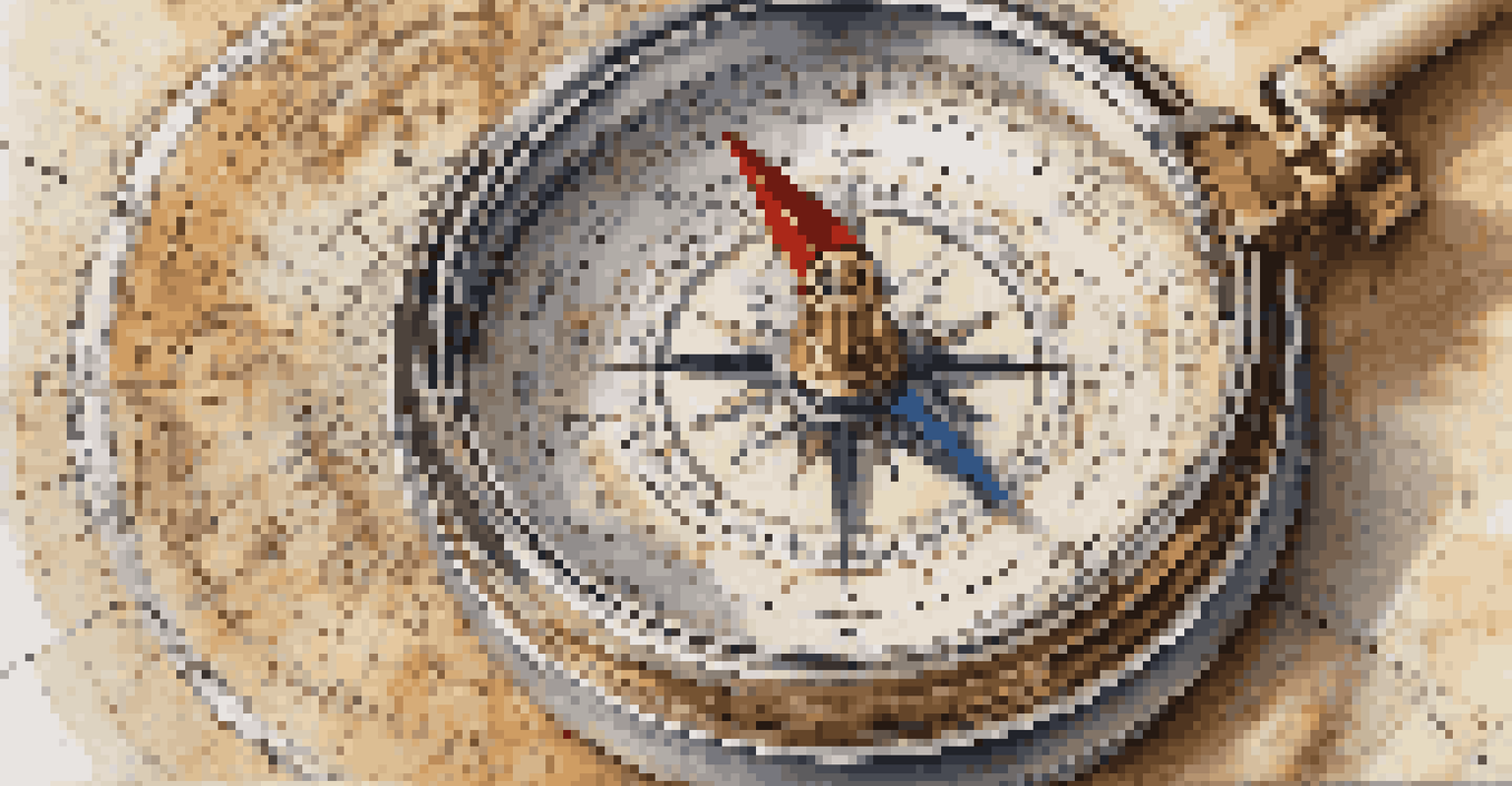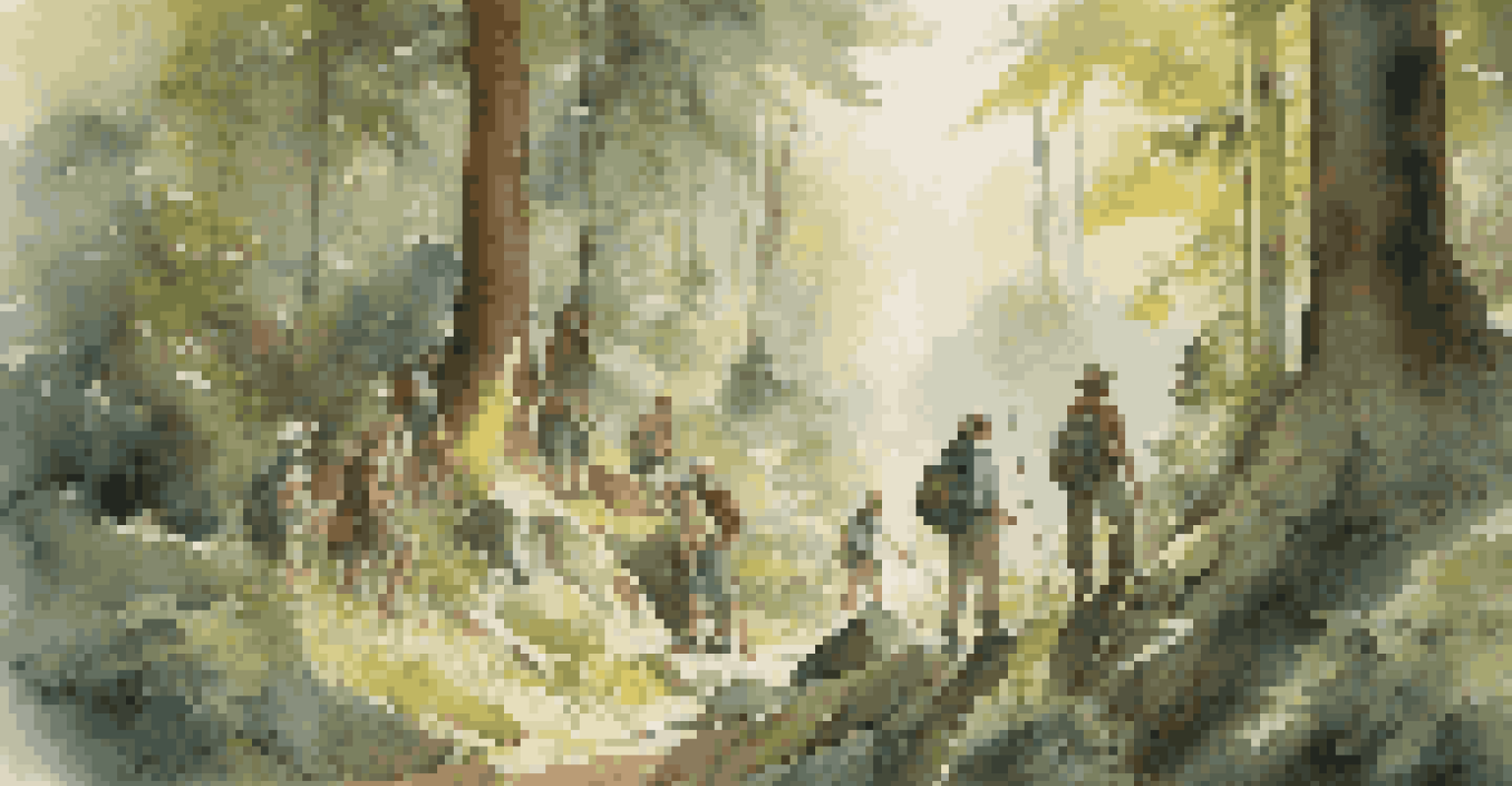The Art of Navigation: Skills for Outdoor Adventure Seekers

Understanding the Basics of Navigation for Adventurers
Navigation is an essential skill for anyone venturing into the great outdoors. It involves understanding how to find your way using various tools and techniques, ensuring a safe and enjoyable experience. At its core, navigation combines an awareness of your surroundings with a set of skills that can help you chart your path, whether you're hiking, camping, or exploring.
Not all those who wander are lost.
There are two primary types of navigation: land navigation and celestial navigation. Land navigation typically involves maps, compasses, and GPS devices, while celestial navigation uses the stars and sun to guide travelers. Both methods can be effective, but it's crucial to understand how and when to use them, as this knowledge can be the difference between a fun adventure and a perilous situation.
Regardless of the method you choose, having a solid grasp of navigation basics will enhance your confidence in the outdoors. Familiarize yourself with topographic maps, compass reading, and how to use landmarks as reference points. This foundational knowledge not only keeps you safe but also enriches your connection with the environment.
Maps: Your Roadmap to Successful Navigation
Maps are an adventurer's best friend, providing a visual representation of the terrain you'll be traversing. Understanding how to read different types of maps—topographic, road, and trail maps—can greatly improve your navigation skills. Each map type presents unique details; for example, topographic maps illustrate elevation changes, which can help you gauge the difficulty of your route.

To effectively use a map, start by familiarizing yourself with key symbols and legends. Knowing what contour lines indicate, or how to identify water sources, can be vital when planning your journey. Additionally, practice orienting the map with your surroundings, aligning it with prominent landmarks to get your bearings.
Master Navigation Basics
Understanding land and celestial navigation techniques enhances outdoor confidence and safety.
Remember, a map is only as good as the person using it. Regular practice in reading and interpreting maps will make you more adept at navigating diverse terrains. The more comfortable you become with maps, the more enjoyable your outdoor experiences will be, as you'll be able to explore new areas with confidence.
The Compass: A Timeless Tool for Direction
A compass is a classic navigation tool that has stood the test of time, and for good reason. It helps adventurers determine their direction relative to the Earth's magnetic field. Understanding how to use a compass in conjunction with a map can significantly enhance your navigation skills, allowing you to traverse unfamiliar landscapes with ease.
The journey of a thousand miles begins with one step.
To use a compass effectively, start by learning its parts: the needle, baseplate, and rotating bezel. To find your direction, hold the compass flat and rotate the bezel until the north end of the needle aligns with the 'N' on the bezel. This simple process allows you to set a bearing and follow a specific path, ensuring you stay on course.
While technology has provided us with GPS devices, the compass remains a reliable backup. It's lightweight, doesn't rely on a power source, and can be used in various weather conditions. By mastering compass skills, you not only gain independence from technology but also deepen your appreciation for the art of navigation.
Using Landmarks for Natural Navigation
Landmarks can serve as natural guides when navigating through the outdoors. Distinctive features like mountains, rivers, or unusual trees can help you orient yourself and keep track of your progress. Developing the ability to identify and remember these landmarks can make a significant difference in your navigation skills.
One effective method is to establish a mental map of your surroundings, taking note of key features as you hike. For example, if you notice a recognizable rock formation or a striking tree, use it as a reference point for your route. This approach can simplify navigation, especially in dense forests where traditional mapping might be challenging.
Utilize Maps Effectively
Familiarizing yourself with different map types and symbols can significantly improve your navigation skills.
It's also beneficial to maintain a constant awareness of your environment. By regularly scanning the horizon and adjusting your route based on what you see, you can create a more intuitive navigation experience. This not only enhances your skills but also allows you to immerse yourself in the beauty of nature.
Tech Tools: GPS and Navigation Apps Explained
In our digital age, GPS devices and navigation apps have revolutionized outdoor navigation. These technologies provide real-time location tracking, route planning, and can even offer detailed maps of your surroundings. However, while they are incredibly useful, it's important to understand their limitations and not rely on them entirely.
GPS devices can sometimes lose signal in dense forests or mountainous areas. That's why it's crucial to have backup navigation skills, such as map reading and compass use. Being familiar with traditional navigation methods ensures that you're prepared for any situation, especially if your tech fails when you're miles away from civilization.
Moreover, many navigation apps allow users to download maps for offline use, which can be a lifesaver when you find yourself without cellular service. Embrace technology, but also make a habit of practicing your navigation skills without it. The combination of tech tools and traditional skills will make you a well-rounded adventurer.
Planning Your Route: The Key to Safe Adventures
Proper route planning is essential for a successful outdoor adventure. Before heading out, take the time to study your map, identify potential hazards, and determine the time needed to complete your journey. This preparation not only boosts your confidence but also ensures you remain safe and aware of your surroundings.
When planning your route, consider the terrain, weather conditions, and your physical abilities. For instance, if you're not an experienced hiker, it might be wise to choose a less challenging path. It's also helpful to inform someone about your plans, including your route and estimated return time, just in case something goes awry.
Combine Tech with Traditional Skills
Using GPS technology alongside traditional navigation methods prepares you for various outdoor scenarios.
Lastly, be flexible during your adventure. Sometimes unexpected obstacles arise, such as a blocked trail or sudden weather changes. Having a well-planned route gives you a solid foundation, but being adaptable allows you to make the most of your journey while ensuring your safety.
Practicing Navigation Skills in the Real World
Like any skill, navigation requires practice to master. Start by taking short hikes in familiar areas where you can experiment with map reading, compass use, and identifying landmarks. As you gain confidence, gradually increase the complexity of your routes and challenge yourself with new environments.
Consider joining local outdoor groups or workshops that focus on navigation skills. These communities can provide valuable resources and support, along with opportunities to learn from experienced adventurers. Plus, practicing with others can make the process more enjoyable and less intimidating.

Finally, keep a journal of your navigation experiences. Documenting your journeys and the techniques you used can help solidify your learning. Reflecting on your adventures not only boosts your skills but also creates lasting memories of your time spent in nature.